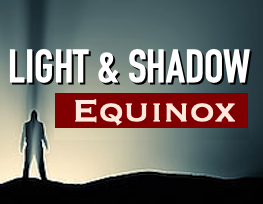
Light and Shadow: The Equinox as a Mirror of Soulful Integration
Finding Balance in the Dance of Life

Finding Balance in the Dance of Life
Twice each year, the Earth pauses in balance. On the Equinox, day and night meet as equals. This is the moment when light and darkness share the sky in equal measure. Though the world quickly tilts again, this brief still point is an invitation. I see it as a great opportunity to ask ourselves about the balance in our own lives.
For me, while I find the cosmic timing of the Equinox fascinating, I also use this as a time of inner alignment. It reminds me that my soul also holds both light and shadow. The light shows me the path forward; the shadow holds the truths I’ve buried, the emotions I’d rather not face, the parts of myself that still wait to be acknowledged.
Shadow work is one way of honoring this balance. It is the practice of turning toward what we have hidden. It may begin with something simple: journaling through uncomfortable feelings, asking hard questions about old wounds, or noticing the old patterns that repeat even when we wish they wouldn’t. It can be unsettling, but it is also deeply human. By facing the parts of ourselves we’ve rejected, we give them room to be transformed.
The Equinox can serve as a reminder that the soul thrives when we stop denying either side of the spectrum. Light without shadow can become blinding, a kind of false perfection. Shadow without light can swallow us in despair. But together, integrated, they create depth, like sunlight through leaves or stars against the night sky.
This moment of balance between night and day offers us a mirror. “Where am I out of balance, what shadow needs my compassion, and what light can be more fully embraced? These are not questions for a single day, but companions for the journey.”
To stay connected to this path, we need practices that root us in presence and open us to mystery. Mindfulness and meditation quiet the noise so we can hear the whispers within. Journaling draws the hidden voice of the soul onto the page. And through the Ritual Postures, we step into a sacred doorway where body and spirit move as one. These practices remind us that balance is not something to chase, but something to embody, like the Equinox itself, a moment of stillness that embraces both light and shadow as part of our wholeness.
And so, the Equinox speaks: standing in our balance, however brief, and remember that wholeness is not perfection but presence. To walk with both light and shadow is to walk in truth, to live in depth, to shine with authenticity. May this season remind us that our souls, like the Earth, are made radiant not by choosing one side over the other, but by honoring the harmony of both.
“Wholeness is not the absence of shadow but the embrace of both, like sunlight through leaves or stars against the night sky.”
Paul Robear Tweet

The name “CUYA” carries with it both history and vision. Rooted in our origins as the Cuyamungue Institute, it now also serves as an acronym — C.U.Y.A. — a guiding symbol that unites our mission:
C — Consciousness: The field of shared awareness that arises in Collective Presence, where the “We” awakens beyond the “I” – moving from the “Me to the We.”
U — Unity: Our alignment with the Cycles of Nature and the rhythms of the cosmos, reminding us that we are woven into a greater fabric of reality. This sense of unity reminds us that our awareness is the shared consciousness that connects all living beings.
Y — Your Awakening: The inner journey of Embodiment and Wisdom, where through direct experience the body remembers. At the CUYA Institute, this awakening is nurtured through Ritual Body Postures and ecstatic trance, where the body itself becomes the doorway to wisdom, presence, and transformation.
A — Ancestral Wisdom: Roots. Our connection to Sacred Lineage, honoring those who walked before us and rooting us in belonging and continuity. Our founder, anthropologist Felicitas D. Goodman looked to some of the oldest, most authentic ancestral records we have — the world’s collection of early and indigenous art — and decoded selected artifacts as embodied “ritual instructions.”